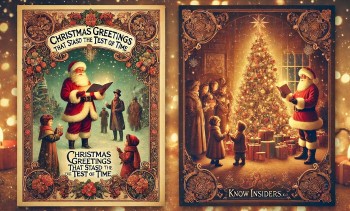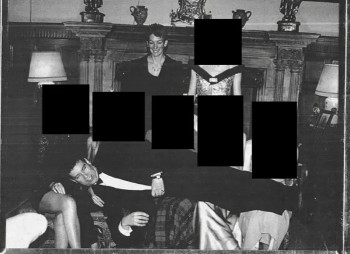What is 'Merry Christmas' and The Oldest Christmas Greetings in History
 Top 10 Funniest and Wackiest Christmas Greetings Ever Sent Top 10 Funniest and Wackiest Christmas Greetings Ever Sent |
 Ancient Christmas Greetings Rediscovered in Old Manuscripts Ancient Christmas Greetings Rediscovered in Old Manuscripts |
Christmas greetings have been an essential part of holiday celebrations for centuries, serving as heartfelt expressions of love, faith, and goodwill. From handwritten notes in the Middle Ages to the elaborately designed Christmas cards of the Victorian era, the history of Christmas greetings is a fascinating journey that reveals the evolution of language, art, and tradition.
 |
| The Oldest Christmas Greetings in History |
The History of the Phrase "Merry Christmas"
The phrase “Merry Christmas” is one of the most recognizable holiday greetings today, but its origins trace back to the early 16th century. The word “merry” was commonly used in Old English to mean “pleasant” or “joyful,” and it frequently appeared in seasonal songs and literature.
First Recorded Usage: The earliest known use of "Merry Christmas" appeared in 1534 in a letter written by English Catholic bishop John Fisher to Thomas Cromwell. Fisher wrote, “And this our Lord God send you a merry Christmas and a comfortable to your heart’s desire.”
Popularization by Charles Dickens: The phrase gained widespread popularity in the 19th century thanks to Charles Dickens’ A Christmas Carol (1843), in which characters frequently exchanged the greeting. Its cheerful tone captured the festive spirit of the era, cementing its place in Christmas culture.
Religious Connotations: While “merry” emphasized joy and celebration, its pairing with “Christmas” also highlighted the sacred nature of the holiday, celebrating the birth of Christ.
 |
| The World’s Oldest Christmas Card |
Ancient Christmas Traditions Reflected in Greetings
Christmas greetings have long been influenced by ancient traditions and customs, many of which were rooted in religious practices and seasonal celebrations:
-
Blessings and Prayers: Medieval Christmas greetings were deeply religious, often taking the form of blessings or prayers for health, prosperity, and divine protection. Manuscripts from this period include phrases like:
-
“God rest ye merry” (a wish for God’s peace and comfort).
-
“May the Lord grant you His grace this Christmastide” (emphasizing spiritual well-being).
-
-
Symbolism in Language: Seasonal symbols such as light, stars, and evergreen trees frequently appeared in messages, reflecting their role in Christmas traditions:
-
Light symbolized hope and Christ’s divine presence.
-
Stars referenced the Star of Bethlehem guiding the Magi.
-
-
Yuletide Festivities: Early greetings often incorporated wishes for joy and feasting, aligning with the festive spirit of Yuletide, a precursor to modern Christmas celebrations.
The Earliest Known Christmas Cards
The tradition of sending Christmas cards as we know them today began in the 19th century, but the idea of sharing holiday messages predates this practice.
-
Early Inspirations: Prior to the invention of commercial Christmas cards, handwritten notes were exchanged during the holiday season. Wealthy families often employed skilled calligraphers to craft elaborate messages adorned with religious imagery or festive motifs.
-
The First Commercial Christmas Card (1843):
-
Creator: Sir Henry Cole, a British civil servant and inventor, commissioned the first commercial Christmas card in 1843. Cole collaborated with artist John Callcott Horsley to create a card that could be easily sent to friends and acquaintances.
-
Design: The card featured a triptych design, with a central illustration of a family enjoying a Christmas feast, flanked by scenes of charity. The words “A Merry Christmas and a Happy New Year to You” appeared prominently.
-
Significance: This innovation made Christmas greetings accessible to a broader audience and marked the beginning of a global tradition.
-
-
Victorian Influence:
-
By the late 19th century, Christmas cards had become wildly popular, with designs featuring everything from snowy landscapes and holly wreaths to depictions of Santa Claus and nativity scenes. These cards often included poetic messages or excerpts from hymns.
-
Advances in printing technology allowed for mass production, making cards affordable for middle-class families.
-
The Evolution of Christmas Greetings
As Christmas greetings transitioned from handwritten letters to printed cards, the messages evolved to reflect broader cultural trends:
• Religious to Secular: While early greetings were deeply religious, Victorian-era cards often blended spiritual themes with secular imagery, such as festive celebrations and winter scenes.
• Personalization: The rise of postal services encouraged people to personalize their greetings, adding handwritten notes alongside printed messages.
• Global Influence: By the 20th century, Christmas greetings had spread worldwide, incorporating cultural nuances and languages from different regions.
Conclusion
The history of Christmas greetings is a testament to the enduring human desire to connect and share joy during the holiday season. From the solemn blessings of the Middle Ages to the colorful, cheerful cards of Victorian times, these messages have evolved while preserving the timeless themes of love, hope, and celebration. As we exchange greetings today, whether digitally or through traditional cards, we continue a centuries-old tradition that reflects the universal spirit of Christmas.
 Meaningful Spanish Christmas Greetings Meaningful Spanish Christmas Greetings Do you know any ways to wish someone a ‘Merry Christmas’ in Spanish? Today, Know Insider will bring you easy-to-learn translations and the correct pronunciation ... |
 The Evolution of Christmas Greetings in the Digital Age The Evolution of Christmas Greetings in the Digital Age As we dive into this fascinating transition, we’ll explore how Christmas greetings have transformed in the digital age, touching on e-cards, social media messages, creative ... |
 Christmas Traditions: Oldest Greetings, Vintage Wishes to Keep Ancient Alive Christmas Traditions: Oldest Greetings, Vintage Wishes to Keep Ancient Alive This article explores famous lines from literary giants like Charles Dickens and Clement Clarke Moore, the enduring charm of vintage Christmas cards, and the traditions ... |


























